by George Chambers
While on a trip this past September to the Canadian Rockies to visit Yoho, Banff, Jasper and Kootenay National Parks my wife Sally and I did some train spotting on the Canadian Pacific Railway (CPR) in British Columbia and Alberta. On the way to Revelstoke we stopped at a rest area on Highway 1 near Craigellachie. This is the place where on November 7, 1885 the last spike was driven to complete the building of the CPR. There is a stone monument with brass plaques at this historical place (Fig 1). The restroom and gift shop are both built to look like depots. While there, an eastbound empty coal train came by (Fig 2). We were spending the night in Revelstoke, so had the afternoon to visit the Revelstoke Railway Museum for the CPR. Inside on display is a Mikado class P-2k #5468 and business car #4 built in 1929 that you can walk through (Fig 5). There are also many photo displays, two wooden bridges, and a display with CPR tracks, ferry boat and car barges all built in HO scale (Fig 4). The two wooden bridges have old time CPR trains on them, complete with old NMRA hook horn couplers (Fig 3). Upstairs in the second story mezzanine is an HO scale CPR layout modeling the Rogers Pass – Clanwilliam Lake (west of Revelstoke) area with nice scenery, buildings and bridges.
Outside of the museum building are CPR freight cars, maintenance of way (MoW), and passenger cars. There are two snowplows, a Jordan spreader and a snow train crew car built from an old box car (Fig 6, Fig 7). We also watched a CPR movie of winter train operations in the early 1950’s. Check out the Revelstoke Railway Museum if you are in the area.
Our motel was right across the street from the CPR main line through Revelstoke, so both east and west bound freight trains came by about every 30 minutes. Most trains we saw, whether coal, grain, oil, potash, lumber, stack, or auto cars had four locomotives – two on the lead, one mid train, and one on the rear. Nowadays the CPR is running GE ES44AC in the GE Evolution Series. Each one costs over 2 million dollars. The four locomotives together have 17,600 horsepower for 170 cars (2.65 miles long trains), which is about 160 feet in HO scale.
Our next stop was in Field on Highway 1 for lunch. We had a cabin reserved for three nights in Yoho National Park about 5 miles from town. The town of Field sits above the CPR railroad tracks and was the main yard from the steam locomotive days for the trip up to Kicking Horse Pass (Fig 8). You can still see the location of the turntable and round house (Fig 10). The steel water tank and depot are still in place (Fig 9). After lunch we checked out the Parks Canada visitor’s center. Inside we found an N scale diorama for the CPR Spiral Tunnels that was a really well built model (Fig 11). The tunnels are located between Field and Kicking Horse Pass.
After checking in at our cabin, we drove up the Yoho Valley Road and stopped at the Upper Spiral Tunnel viewpoint. We could see a CPR freight train using the tunnel (Fig 12, Fig 13). At the end of the road we hiked a trail to see the second highest water fall in Canada, Takakkaw Falls at 1,265’.
The two spiral tunnels were built in 1909 to replace a 4.5% grade between Field and Kicking Horse Pass. The new grade is 2.2%. The #1 Upper Spiral Tunnel is a 10 degree track curvature with a 573 feet radius (about 79 inches in HO scale) on a 1.66 % grade. The #2 Lower Spiral Tunnel is the same radius and on a 1.62% grade. On our drive back from Jasper we stopped at the Lower Spiral Tunnel viewpoint on Highway 1. At this viewpoint we watched a CPR freight train going down grade through the spiral tunnel and looping under itself. The viewpoint also has several historical signs describing the tunnels construction and a model of them on display. During the big steam days, the CPR ran class T1a and T1b Selkirk 2-10-4 locomotives through the tunnels along with Santa Fe type class S2a 2-10-2 locomotives until 1952 when the diesel electric locomotives took over. In 1931 the CPR built one “super” Selkirk T4a locomotive with three boilers and pistons in their own shop. Being bigger proved not to be better. This loco had 63 inch driving wheels, weighed in at 795,300 pounds, and had a traction effort of 83,300 pounds. The tender held 11,500 gallons of water and 4,100 gallons of fuel oil. This loco proved to be a maintenance nightmare and spent 30% of its time in the shop getting repaired. It was pulled from service in 1936 after only 50,410 miles and cut up for scrap in 1940. Only its tender and snowplow were saved from the scrapers torch.
On our day to visit Lake Louise and Banff we saw that the Lake Louise train station is now a restaurant. The CPR depot in Banff is still used for the Rocky Mountaineer passenger train that goes between Vancouver and Banff (Fig 15). It costs between $1,500 and $10,000 for a two day train ride. The VIA passenger train no longer goes through Banff and the Spiral Tunnels on the CPR as it travels on the Canadian National tracks through Jasper. While at the depot we spotted a heavy weight CPR passenger trains parked on a nearby siding (Fig 14).
On our last night in the Canadian Rockies we spent the night in a log cabin in Kootenay National Park at the Storm Mtn. Lodge. The log lodge and cabins were built by the CPR back in 1922. So besides being able to enjoy the mountains, lakes and many water falls, we also got to do some CPR train spotting.

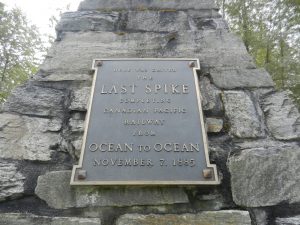
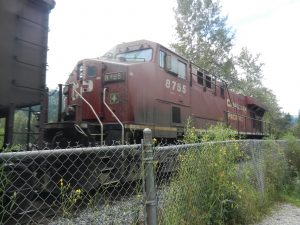
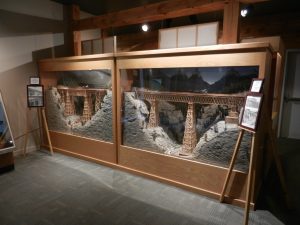
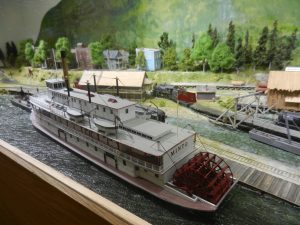
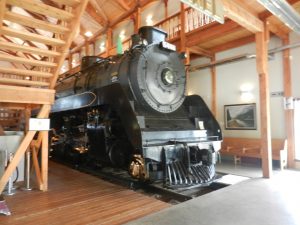
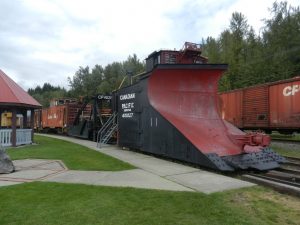
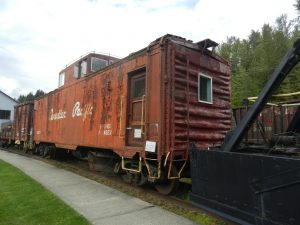
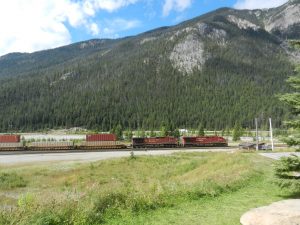
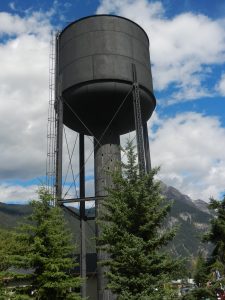
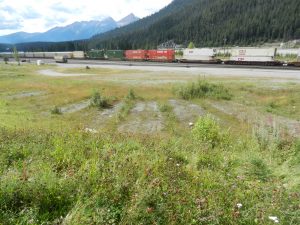
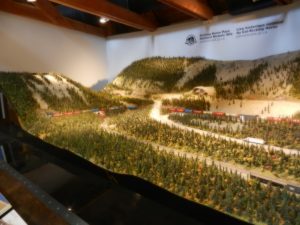
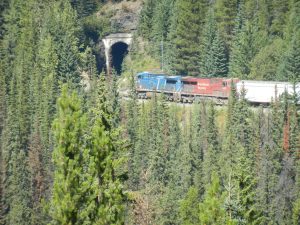
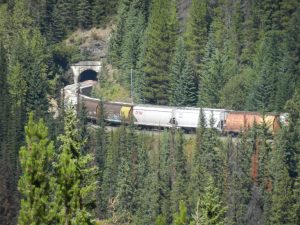
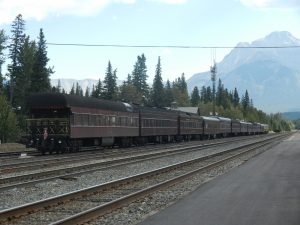
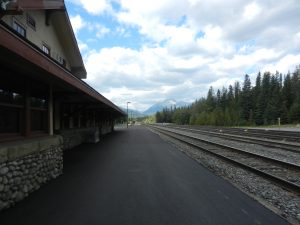
Regarding the last spike on the Canadian Pacific, at Craigellachie, one of my favorite stories comes from William Cornelius Van Horne, the director of construction.
Many of the Canadian Pacific executives and financial backers were immigrants from Scotland, a notoriously thrifty bunch. And as a federal government project, politicians are always looking for a hand-out.
In contrast to the ceremonial gold or silver spikes often used to mark the completion of a major American railroad, the CPR Last Spike was a conventional iron spike. When it was suggested to Van Horne a gold spike be used he replied “The last spike will be just as good an iron one as there is between Montreal and Vancouver, and anyone who wants to see it driven will have to pay full fare.”
The last time I took pictures in Field was in the 1980’s. At that time a portion of the roundhouse was still standing along with the boiler shop and at least one wooden structure. The turntable was still in use and some MOW cars were in the remaining piece of the roundhouse. I never went over to the station though I should have but my work schedule had me back on the highway after a few hours in town. Thanks for showing what the site is like now.
The scene with the stern wheeler is the end of the Arrowhead branch from the HO railroad built by Brian Pate. If you look at the left front corner of the station roof in the photo, you will see a couple shingles missing. I was one of the first people to operate a train on that part of the railroad and found that the caboose would snag on the roof. Brian performed a simple fix by removing the offending shingles!!
It was a wonderful and amazing railroad.